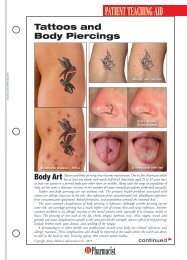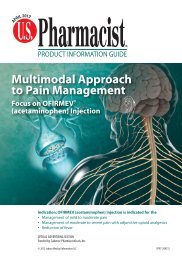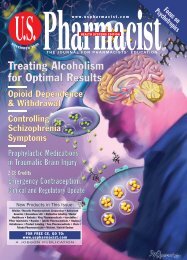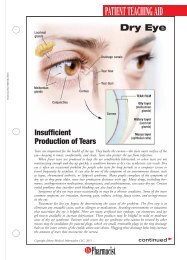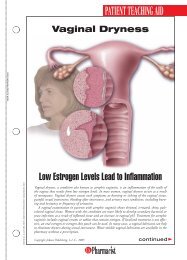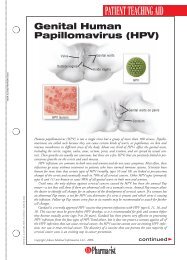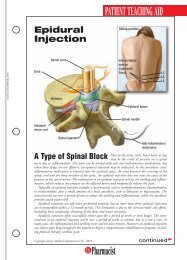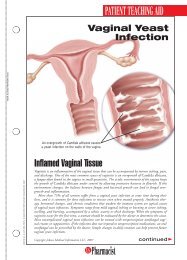View PDF Edition - U.S. Pharmacist
View PDF Edition - U.S. Pharmacist
View PDF Edition - U.S. Pharmacist
Create successful ePaper yourself
Turn your PDF publications into a flip-book with our unique Google optimized e-Paper software.
Brimonidine Tartrate Ophthalmic Solution, 0.15%<br />
Sterile<br />
DESCRIPTION<br />
Brimonidine Tartrate Ophthalmic Solution, 0.15% (1.5 mg brimonidine tartrate per mL equivalent to 1.0 mg<br />
brimonidine free base per mL) is a relatively selective alpha-2-adrenergic agonist for ophthalmic use. The<br />
chemical name of brimonidine tartrate is 5-bromo-6-(2-imidazolidinylideneamino) quinoxaline L-tartrate. It is an<br />
off-white to pale yellow powder. It has a molecular weight of 442.24 as the tartrate salt, and is both soluble in<br />
water (1.5 mg/mL) and in the product vehicle (3.0 mg/mL) at pH 7.2. The structural formula is:<br />
Formula: C 11<br />
H 10<br />
BrN 5<br />
4<br />
H 6<br />
O 6<br />
CAS Number: 59803-98-4<br />
HN<br />
N<br />
NH<br />
Br<br />
In solution, Brimonidine Tartrate Ophthalmic Solution, 0.15% has a clear, greenish-yellow color. It has an<br />
osmolality of 250 – 350 mOsmol/kg and a pH of 6.6-7.4.<br />
Each mL of Brimonidine Tartrate Ophthalmic Solution, 0.15% contains: Active ingredient: brimonidine tartrate<br />
0.15% (1.5 mg/mL) Inactives: povidone; boric acid; sodium borate; calcium chloride; magnesium chloride;<br />
potassium chloride; mannitol; sodium chloride; POLYQUAD* 0.001% (0.01 mg/mL); purified water; with<br />
hydrochloric acid and/or sodium hydroxide to adjust pH.<br />
CLINICAL PHARMACOLOGY<br />
Mechanism of Action: Brimonidine Tartrate Ophthalmic Solution, 0.15% is an alpha-2 adrenergic receptor<br />
agonist. It has a peak ocular hypotensive effect occurring at two hours post-dosing. Fluorophotometric studies<br />
in animals and humans suggest that brimonidine tartrate has a dual mechanism of action by reducing aqueous<br />
humor production and increasing uveoscleral outflow.<br />
Pharmacokinetics:<br />
In a pharmacokinetic study, 14 healthy subjects (4 males and 10 females) received a single topical ocular<br />
administration of Brimonidine Tartrate Ophthalmic Solution, 0.15%, one drop per eye. The peak plasma<br />
concentrations (C max<br />
) and AUC 0-inf<br />
max<br />
was 1.7 ± 0.7<br />
hours after dosing. The systemic half-life was approximately 2.1 hours.<br />
Brimonidine is metabolized primarily by the liver. In vitro metabolism data from human microsomal fractions and<br />
liver slices indicate that brimonidine undergoes extensive hepatic metabolism.<br />
Urinary excretion is the major route of elimination of brimonidine and its metabolites. Approximately 87%<br />
of an orally administered radioactive dose of brimonidine was eliminated within 120 hours, with 74% of the<br />
radioactivity recovered in the urine.<br />
Special Populations<br />
Brimonidine Tartrate Ophthalmic Solution, 0.15% has not been studied in patients with hepatic or renal impairment.<br />
Because of the low systemic drug exposure following topical ocular administration of Brimonidine Tartrate Ophthalmic<br />
Solution, 0.15%, no dose adjustment is necessary when treating patients with hepatic or renal impairment.<br />
Clinical Evaluations:<br />
Elevated IOP presents a major risk factor in glaucomatous field loss. The higher the level of IOP, the greater the<br />
likelihood of optic nerve damage and visual field loss. Brimonidine tartrate has the action of lowering intraocular<br />
pressure with minimal effect on cardiovascular and pulmonary parameters.<br />
A clinical study was conducted to evaluate the safety and efficacy of Brimonidine Tartrate Ophthalmic Solution,<br />
0.15% compared to Alphagan ® P** administered three-times-daily in patients with open-angle glaucoma or<br />
ocular hypertension. The results indicated that Brimonidine Tartrate Ophthalmic Solution, 0.15% is equivalent in<br />
IOP-lowering effect to Alphagan ® P (brimonidine tartrate ophthalmic solution), 0.15%, and effectively lowers IOP<br />
in patients with open-angle glaucoma or ocular hypertension by 2 - 6 mm Hg.<br />
INDICATIONS AND USAGE<br />
Brimonidine Tartrate Ophthalmic Solution, 0.15% is indicated for the lowering of intraocular pressure in patients<br />
with open-angle glaucoma or ocular hypertension.<br />
CONTRAINDICATIONS<br />
Brimonidine Tartrate Ophthalmic Solution, 0.15% is contraindicated in patients with hypersensitivity to<br />
brimonidine tartrate or any component of this medication. It is also contraindicated in patients receiving<br />
monoamine oxidase (MAO) inhibitor therapy.<br />
PRECAUTIONS<br />
General:<br />
Although Brimonidine Tartrate Ophthalmic Solution, 0.15% had minimal effect on the blood pressure of patients<br />
in clinical studies, caution should be exercised in treating patients with severe cardiovascular disease.<br />
Brimonidine Tartrate Ophthalmic Solution, 0.15% has not been studied in patients with hepatic or renal<br />
impairment; caution should be used in treating such patients.<br />
Brimonidine Tartrate Ophthalmic Solution, 0.15% should be used with caution in patients with depression,<br />
cerebral or coronary insufficiency, Raynaud’s phenomenon, orthostatic hypotension, or thromboangiitis<br />
obliterans. Patients prescribed IOP-lowering medication should be routinely monitored for IOP.<br />
N<br />
N<br />
COOH<br />
H<br />
HO<br />
C<br />
C<br />
OH<br />
H<br />
COOH<br />
Information for Patients:<br />
As with other drugs in this class, Brimonidine Tartrate Ophthalmic Solution, 0.15% may cause fatigue and/or<br />
drowsiness in some patients. Patients who engage in hazardous activities should be cautioned of the potential<br />
for a decrease in mental alertness.<br />
Drug Interactions:<br />
Although specific drug interaction studies have not been conducted with Brimonidine Tartrate Ophthalmic<br />
Solution, 0.15%, the possibility of an additive or potentiating effect with CNS depressants (alcohol, barbiturates,<br />
opiates, sedatives, or anesthetics) should be considered. Alpha-2 agonists, as a class, may reduce pulse and<br />
blood pressure. Caution in using concomitant drugs such as beta-blockers (ophthalmic and systemic), antihypertensives<br />
and/or cardiac glycosides is advised.<br />
Tricyclic antidepressants have been reported to blunt the hypotensive effect of systemic clonidine. It is not<br />
known whether the concurrent use of these agents with Brimonidine Tartrate Ophthalmic Solution, 0.15% in<br />
humans can interfere with its IOP-lowering effect. No data on the level of circulating catecholamines after<br />
Brimonidine Tartrate Ophthalmic Solution, 0.15% administration are available. Caution, however, is advised in<br />
patients taking tricyclic antidepressants, which can affect the metabolism and uptake of circulating amines.<br />
Carcinogenesis, Mutagenesis, and Impairment of Fertility:<br />
No compound-related carcinogenic effects were observed in either mice or rats following a 21-month and a<br />
24-month study, respectively. In these studies, dietary administration of brimonidine tartrate at doses up to<br />
2.5 mg/kg/day in mice and 1.0 mg/kg/day in rats achieved 60 and 50 times, respectively, the plasma drug<br />
concentration estimated in humans treated with one drop of Brimonidine Tartrate Ophthalmic Solution, 0.15%<br />
into both eyes.<br />
Brimonidine tartrate was not mutagenic or cytogenic in a series of in vitro and in vivo studies including the Ames<br />
test, chromosomal aberration assay in Chinese hamster ovary (CHO) cells, a host-mediated assay and cytogenic<br />
studies in mice, and dominant lethal assay.<br />
Pregnancy: Teratogenic Effects: Pregnancy Category: B<br />
Reproductive studies performed in rats and rabbits with oral doses of 0.66 mg base/kg revealed no evidence<br />
of harm to the fetus due to Brimonidine Tartrate Ophthalmic Solution, 0.15%. Dosing at this level produced an<br />
exposure in rats and rabbits that is 80 and 40 times higher than the exposure seen in humans, respectively.<br />
There are no adequate and well-controlled studies in pregnant women. In animal studies, brimonidine crossed<br />
the placenta and entered into the fetal circulation to a limited extent. Brimonidine Tartrate Ophthalmic Solution,<br />
0.15% should be used during pregnancy only if the potential benefit to the mother justifies the potential risk to<br />
the fetus.<br />
Nursing Mothers:<br />
It is not known whether this drug is excreted in human milk. In animal studies, brimonidine tartrate was excreted<br />
in breast milk. A decision should be made whether to discontinue nursing or to discontinue the drug, taking into<br />
account the importance of the drug to the mother.<br />
Pediatric Use:<br />
In a well-controlled clinical study conducted in pediatric glaucoma patients (ages 2 to 7 years) the most<br />
commonly observed adverse events with brimonidine tartrate ophthalmic solution 0.2% dosed three-timesdaily<br />
were somnolence (50%-83% in patients ages 2 to 6 years) and decreased alertness. In pediatric patients<br />
7 years of age or older (>20 kg), somnolence appears to occur less frequently (25%). Approximately 16% of<br />
patients on brimonidine tartrate ophthalmic solution discontinued from the study due to somnolence.<br />
The safety and effectiveness of brimonidine tartrate ophthalmic solution have not been studied in pediatric<br />
patients below the age of 2 years. Brimonidine tartrate ophthalmic solution is not recommended for use in<br />
pediatric patients under the age of 2 years. (Also refer to ADVERSE REACTIONS section.)<br />
Geriatric Use:<br />
No overall differences in safety or effectiveness have been observed between elderly and other adult patients.<br />
ADVERSE REACTIONS<br />
Adverse events occurring in approximately 10-20% of the subjects included: allergic conjunctivitis, conjunctival<br />
hyperemia, and eye pruritis.<br />
Adverse events occurring in approximately 5-9% of the subjects included: burning sensation, conjunctival<br />
folliculosis, hypertension, ocular allergic reaction, oral dryness, and visual disturbance.<br />
Events occurring in approximately 1-4% of subjects included: allergic reaction, arthralgia, arthritis, asthenia,<br />
blepharitis, blepharoconjunctivitis, blurred vision, bronchitis, cataract, chest pain, conjunctival edema,<br />
conjunctival hemorrhage, conjunctivitis, cough, dizziness, diabetes mellitus, dyspepsia, dyspnea, epiphora, eye<br />
discharge, eye dryness, eye irritation, eye pain, eyelid edema, eyelid erythema, fatigue, flu syndrome, follicular<br />
conjunctivitis, foreign body sensation, gastrointestinal disorder, headache, hypercholesterolemia, hypotension,<br />
infection, insomnia, joint disorder, keratitis, lid disorder, osteoporosis, pharyngitis, photophobia, rash, rhinitis,<br />
sinus infection, sinusitis, somnolence, stinging, superficial punctate keratopathy, tearing, visual field defect,<br />
vitreous detachment, vitreous disorder, vitreous floaters, and worsened visual acuity.<br />
The following events were reported in less than 1% of subjects: corneal erosion, nasal dryness, and taste<br />
perversion.<br />
The following events have been identified during post-marketing use of brimonidine tartrate ophthalmic<br />
solutions in clinical practice. Because they are reported voluntarily from a population of unknown size, estimates<br />
of frequency cannot be made. The events, which have been chosen for inclusion due to either their seriousness,<br />
frequency of reporting, possible causal connection to brimonidine tartrate ophthalmic solutions, or a combination<br />
of these factors, include: bradycardia; iritis; miosis; skin reactions (including erythema, eyelid pruritis, rash, and<br />
vasodilation); and tachycardia. Apnea, bradycardia, hypotension, hypothermia, hypotonia, and somnolence have<br />
been reported in infants receiving brimonidine tartrate ophthalmic solutions.<br />
OVERDOSAGE<br />
No information is available on overdosage in humans. Treatment of an oral overdose includes supportive and<br />
symptomatic therapy; a patent airway should be maintained.<br />
DOSAGE AND ADMINISTRATION<br />
The recommended dose is one drop of Brimonidine Tartrate Ophthalmic Solution, 0.15% in the affected eye(s)<br />
three-times-daily, approximately 8 hours apart.<br />
Brimonidine Tartrate Ophthalmic Solution, 0.15% may be used concomitantly with other topical ophthalmic drug<br />
products to lower intraocular pressure. If more than one topical ophthalmic product is being used, the products<br />
should be administered at least 5 minutes apart.<br />
HOW SUPPLIED<br />
Brimonidine Tartrate Ophthalmic Solution, 0.15% is supplied sterile in opaque white LDPE plastic bottles and<br />
natural tips with purple polypropylene caps as follows:<br />
5 mL in 8 mL bottle NDC 61314-144-05<br />
10 mL in 10 mL bottle NDC 61314-144-10<br />
15 mL in 15 mL bottle NDC 61314-144-15<br />
Storage: Store at 15°-25° C (59° - 77°F).<br />
Rx Only<br />
Distributed by:<br />
Falcon Pharmaceuticals, Ltd.<br />
Fort Worth, Texas 76134<br />
Manufactured by:<br />
Alcon Laboratories, Inc.<br />
Fort Worth, Texas 76134<br />
Printed in USA<br />
*POLYQUAD is a registered trademark of Alcon Research, Ltd.<br />
**ALPHAGAN P is a registered trademark of Allergan, Inc.<br />
349040-1008




